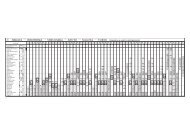CENTRAL JAPAN RAILWAY COMPANY Annual Report 2007
CENTRAL JAPAN RAILWAY COMPANY Annual Report 2007
CENTRAL JAPAN RAILWAY COMPANY Annual Report 2007
Create successful ePaper yourself
Turn your PDF publications into a flip-book with our unique Google optimized e-Paper software.
Travel time shortened with early morning and late-night trains. The shortest travel<br />
time between Tokyo and Shin-Osaka is 2 hours and 25 minutes.<br />
(2) A new “Nozomi 99” (for Hakata) originates at Shinagawa Station at 6a.m.<br />
The train is a new Series N700<br />
The train arrives at stations earlier, such as arriving at Shin-Osaka Station at 8:19a.m.<br />
and at Shin-Kobe Station at 8:34a.m. (11 minutes earlier than the “Nozomi 1” which<br />
originates at Tokyo Station at 6a.m.).<br />
(3) Morning inbound “Nozomi” services and nighttime outbound “Nozomi” services are<br />
added to further increase convenience to the metropolitan area from the Kansai and<br />
Nagoya directions.<br />
(4) The number of inbound “Nozomi” and “Hikari” services that stop at Shin-Yokohama<br />
Station during the morning hour of 8 o’clock increased by six.<br />
Improvement of convenience to Shin-Yokohama Station from the Kansai/Nagoya<br />
directions during the morning.<br />
Introducing the new Series N700<br />
JR Central and JR West jointly developed the next-generation Shinkansen rolling stock<br />
Series N700 which employs the latest technologies. With a maximum speed of 270 km/h<br />
for the Tokaido section and 300 km/h for the Sanyo section, the Series N700 increased<br />
the speed on curves by adopting a body inclining system for the first time in Japan’s<br />
Shinkansen history and improved acceleration performance thereby enabling a<br />
shortening of travel time. In addition, we have improved ride quality including comfort<br />
and quietness, made environmental adaptations and achieved drastic savings in energy<br />
consumption. We have made the Series N700 more energy efficient by drastically<br />
reducing wind resistance, for example, through employing a cover-all hood. The Series<br />
N700 improves maximum speed from 220km/h to 270km/h in comparison with the first<br />
type of the Shinkansen (the Series 0), while reducing energy consumption by 32%. Just<br />
for your information, if the Series N700 runs at the same maximum speed as the Series 0<br />
(220km/h), energy consumption is reduced by 49%.<br />
1. Specifications of the Series N700<br />
Along with starting new services that introduce the latest technologies, the Series N700<br />
offers an “even more comfortable interior space” that meets the various needs of our<br />
customers.<br />
1. Offering a Relaxing, Comfortable, and Quality Cabin Environment<br />
“Enhanced riding comfort” through the installation of an advanced semi-active<br />
suspension system on all cars<br />
“Quiet Passenger Cabin” with the adoption of a cover-all hood, a first for Japan<br />
“Completely separating smoking and nonsmoking sections” by making all seats<br />
nonsmoking and installing smoking rooms<br />
“Improvement of First class ‘Green car’ quality” (adopting Synchronized Comfort Seats)<br />
“Increasing the width of seats in regular cars”<br />
Tokaido Shinkansen Daily Departures<br />
<br />
(Trains / day)<br />
<br />
<br />
<br />
<br />
<br />
<br />
<br />
<br />
<br />
<br />
<br />
<br />
<br />
<br />
<br />
<br />
<br />
<br />
<br />
<br />
<br />
<br />
<br />
<br />
Nozomi<br />
Hikari<br />
<br />
<br />
Kodama<br />
Note: Departures shown are as of the beginning of each month,<br />
and exclude extra trains<br />
Cover-All Hood<br />
Information Displays<br />
Seats for Green Car (First Class)<br />
Smoking Room<br />
15





